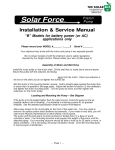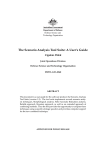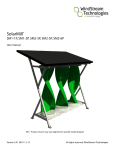Download User Manual - College of Agricultural, Consumer and Environmental
Transcript
Solar-Powered Water Pump Design Spreadsheet Version II: User Manual Circular 671 Thomas Jenkins1 Cooperative Extension Service • Engineering New Mexico Resource Network College of Agricultural, Consumer and Environmental Sciences • College of Engineering SPREADSHEET OVERVIEW The purpose of this user manual and accompanying Microsoft Excel spreadsheet (http://aces.nmsu.edu/pubs/_circulars/ CR671/CR671.xlsm) is to guide you through the basic process of designing a solar-powered water pumping system and aid in feasibility and implementation decisions. The spreadsheet is designed to allow you to enter values such as well location and depth, number and type of animals, etc. By entering different values, you can investigate a variety of scenarios before making implementation decisions. There are NO expressed or implied guarantees with this spreadsheet/user manual, nor is it intended to replace professional expertise. It is also important to note that the system is designed around the use of a small set of submersible DC pumps and photovoltaic (PV) panels as a teaching example ONLY; other pumps and PV panels are available, and there are no endorsements of any kind. It is useful to first read the accompanying paper2 and skim this manual to get a basic understanding of the spreadsheet and general overview of solar water pumping. Some experience with computers and spreadsheets is helpful. The spreadsheet consists of different “sheets” or pages that are indexed via tabs at the very bottom of the window. There is a title sheet, six sheets that represent the six main sequential steps in the design methodology, and a conclusion sheet (Figure 1). The currently selected sheet has a white background, and in Figure 1 this is the Title Page sheet. On each sheet, there are different shaded boxes, areas, or spreadsheet cells. There are light-purple and light-blue shaded areas that are instructions and user notes that you should read when using each sheet. The green cells are where you can enter information. To enter a value, move the cursor and click on the green cell (or box), enter your value in that cell (typically a number), and press the “enter” or “return” key on your keyboard. The orange boxes display intermediate values that are calculated by the spreadsheet. The yellow boxes show the final calculations in each design step, and they will often be used in other calculations and to generate the final design specifications. 1 2 Some input cells have a red triangle in their top right corner. When you place the cursor onto that cell, a “popup” note is displayed giving an additional short explanation related to the information in that cell. Some cell entries are restricted in their allowable values. For example, the “Multiplier” cell in the Daily Water Requirement sheet (Figure 6) will only accept entries between 0–20. If you enter a value outside this range, an error message will be displayed and you must re-enter a valid value in this cell before continuing. Some entry cells may also have a “drop-down” menu associated with them. A cell’s menu can be accessed by placing the cursor on the cell and clicking on it. A note is then displayed and a drop-down menu tab is displayed to the right of the cell. When this tab is clicked, the dropdown menu displays the valid entries for this cell. Just click on any menu entry to make it the cell’s input value. STEP-BY-STEP DESIGN PROCEDURE Step 1. Gather Information To begin the design procedure, it is useful to have some information about the existing or proposed well. You should sketch out some basic parameters using Figure 2 as a simple example. The key values needed are the discharge elevation, water level, pipe fittings (such as elbows and valves), and total length of pipe and its nominal inside diameter. Units of length are feet. For existing wells, a well driller log often has this information. Water level is defined as the lowest depth of the water in the well, including any draw-down levels and seasonal variations; this is not the pump level, which is the depth of the pump from the surface to below the water level. Draw-down is the lowering of water in the well due to pumping activity. Seasonal variations are seasonal changes in the water level in the well. Discharge elevation is the elevation from the ground level to the discharge point. Total length of pipe is the pipe length from the pump to the discharge point (including any horizontal Professor ([email protected]), Department of Engineering Technology and Surveying Engineering, New Mexico State University. Circular 670, Designing Solar Water Pumping Systems for Livestock (http://aces.nmsu.edu/pubs/_circulars/CR670.pdf ). To find more resources for your business, home, or family, visit the College of Agricultural, Consumer and Environmental Sciences on the World Wide Web at aces.nmsu.edu Figure 1. Different sheet tabs within the spreadsheet. Elbow Valve Horizontal pipe run Trough Water level Draw-down Pump level Pump Well Water Figure 2. Basic schematic of a pumping system from a well to a storage tank. Figure 3. Solar Resource sheet. Circular 671 • Page 2 pipe run such as from the wellhead to the storage tank). There is another example diagram on the Total Dynamic Head sheet of the spreadsheet that is color-coded for your convenience. Step 2. Determine Available Solar Resource Once you determine basic well information, open the spreadsheet and click on the Title Page sheet (the leftmost tab at the bottom of the spreadsheet; see Figure 1). Read the title page material and view the referenced internet video on solar pumping. Next, continue to the first design sheet by clicking on the Solar Resource sheet tab at the bottom of the spreadsheet. The purpose of the Solar Resource sheet (Figure 3) is to calculate the total daily insolation (i.e., sunlight) at the well’s location. There are four green cell entries for this step: the state, the season, the latitude in the state, and how the PV panels are mounted/tilted. First select the state—Arizona (AZ), New Mexico (NM), Colorado (CO), Utah (UT), Nevada (NV), Wyoming (WY), or Montana (MT)—where you plan to install your solar system by clicking on the green cell and using the state menu. Then, using the chosen state’s map as an aid, enter the nearest latitudinal coordinate for your well’s location in the “Latitude” cell. For example, New Mexico is located between latitudes 31° and 36°. A green highlight will appear on the state map indicating the latitude you have entered; Figure 4 shows an example in which 31° has been entered as the latitude for a location in New Mexico. Next, you may choose, in the green cell below the “Latitude” cell, the season (i.e., winter, summer, or all year) during which you will be pumping water. A summer choice is appropriate if you plan to only pump water during the summer months (i.e., May–September), winter would be for winter only pumping, and all year would obviously be year-round pumping. This choice will be used to calculate the amount of solar energy available to run your system (summer has more solar energy), as well as the livestock and other water requirements for different seasons; summer livestock water requirements are significantly higher than winter requirements, and therefore more water must be supplied for the summer season. Conservative, worst-case values are used for determining available solar energy. For example, a winter or all-year choice would use sunlight amounts for December 21 (the shortest day of the year, which has, consequently, the least amount of sunlight), while a summer choice would use values from mid-May. By using worstcase values, we can expect to supply sufficient water under all conditions. For year-round pastures, we will use winter sun values and summer water usage values as our worst-case parameters. Figure 4. Example of a state map with latitude 31° selected. PV panel Tilt angle Ground Figure 5. PV panel tilt angles. PV panels supply power (electricity) to the pump and are typically pointed due south and tilted at some angle from the horizontal to help capture the most sunlight; see Figure 5 for an illustration. The tilt angle can be fixed (i.e., does not change throughout the year) or physically changed to a seasonal angle. To this end, use the drop-down menu in the “Tracker or Tilt Angles” entry cell to enter one of three possible angle choices. Circular 671 • Page 3 Enter “Latitude” if you plan to tilt the PV panels at a fixed angle equal to the latitude of your location. A rule of thumb for a fixed-tilt angle for all-year pumping is to tilt the PV at an angle equal to the well’s latitude (e.g., 35° in the case of the Albuquerque area). Enter “1-Axis Tracker” if you plan to use a 1-axis solar tracker. Single-axis or 1-axis solar “trackers” are devices that track or follow the sun as it moves from east to west during the day. Using a tracker can considerably increase the total solar energy absorbed by the PV, which means there is more energy and you can size pumps and panels smaller and cheaper. However, a tracker adds additional costs and system complexity. Two-axis trackers are available, but their additional cost and complexity typically do not justify them for this usage. Enter “+/- 15°” if you plan to change tilt angles so they are optimized for winter- or summer-only seasons (i.e., latitude plus 15° for winter, latitude minus 15° for summer). For example, if you plan to water only a summer pasture, the PV panels will collect more sun energy if they are more horizontal, tilted to an optimal angle equal to the location’s latitude minus 15°; this angle is good for the higher summer sun, but bad for the lower winter sun. If watering in Albuquerque at latitude of ~35°, for example, the PV panels for a summer-only watering season should be tilted at 20° (35° minus 15°) from the horizontal. By being flatter, the panel will catch more of the higher summer sun. Winter-only tilt angle would be 50° (35° plus 15°) from the horizontal, catching more of the lower winter sun. Most users use a fixed-tilt angle because of its ease of operation and maintenance. See the References section for more discussions. Once we have selected the state, latitude, watering season, and tilt angle type, the spreadsheet will determine the total sunlight for this location. This value will be displayed in the yellow cell labeled “Total Daily Insolation” and is the available energy we will have to power the system. Step 3. Determine Daily Water Requirement Navigate to the next sheet titled Daily Water Requirement (Figure 6), whose purpose is to calculate the amount of water you need per day based on your seasonal choice (winter, summer, or all year), number and type of animals to be watered, and any other water needs. To calculate the needed water, input the number of each of the animal type you want to water in the green cells under the “Quantity” column, which is under the “Water Requirements” general heading. If you do not have an animal type, just leave that cell blank (or enter 0). If something is not listed, input the amount of gallons that item requires per 3 4 day in the green cell labeled “Other Water Requirements.” The amount of water for each animal per day is calculated by multiplying the number of each animal type (e.g., 5 horses) by the amount of water that the animal needs per day (e.g., 15 gal/day). The amount of water each animal needs varies due to animal size, season, and location (e.g., desert vs. mountain, summer vs. winter, etc.3). The Daily Water Requirement sheet shows common regional water requirements for various animals in the bottom left area of the window, but you may change these default values by entering values in the green cells under the general heading “Typical water requirement for this region” (Figure 7). Grey-colored cells indicate a recommended range of typical watering values for your seasonal choice. Again, the spreadsheet calculations are typically the worst-case values based on your seasonal choice from the earlier sheet (e.g., summer water values are used for animals that will be in summer or year-round pastures). Do not leave any of these cells blank or 0. The system will calculate a total daily water requirement for each animal type and then sum all these to get a total “Daily Water Requirement,” which is displayed in yellow. You may also enter a percentage multiplier (0–20%) that will add an additional percentage to this calculation. This additional water can be used to offset evaporation, refill a storage tank, or adjust for anticipated growth in water requirements. The new adjusted total is also in yellow as gal/day (and liters/day). Like windmills, solar pumping systems often pump extra water into a storage tank that supplies water to livestock at night or during periods of low light (or calm days in the case of windmills). You may enter a number of days for storage and the system will provide a general size of a storage tank that you might use with the system. This is informational only and has no other use in the design. For example, a normal storage value for sunny regions like New Mexico is three days of water, but it may be up to ten depending on various factors4. Step 4. Determine How Hard the Pump Must Work to Move Water From the Well Navigate to the next sheet titled Total Dynamic Head (Figure 8), whose function is to determine how hard a pump must work to move water from the well, through the total length of piping and all fittings, and to a discharge level at a certain flow rate (gallons per minute [gpm]) to meet the daily water requirement. This calculated value, called “Total Dynamic Head (TDH),” is used to determine the pump size and PV panels required to power it. You may contact your county Extension agent for specific values for your location, season, conditions, and animal types. Consult your county Extension agent for additional information concerning water storage requirements for your area. Circular 671 • Page 4 Figure 6. Daily Water Requirement sheet. Figure 7. Water requirement table. Figure 8. Total Dynamic Head sheet. Circular 671 • Page 5 Take the well values that you determined in step 1 and enter them into their associated green cells on the right side of the Total Dynamic Head sheet. Use Figure 2 and the color-coded example drawing on the left side of the Total Dynamic Head sheet as an aid, but note that these diagrams are just examples to illustrate various terms. The entered well values are used to calculate the total vertical lift of the system plus the friction losses in the pipe and fittings used to transport the water from the well to the discharge point, giving TDH. Water level is the lowest depth of water in the well, including any draw-down and seasonal variations. This is not the depth of the pump, which is located deeper (i.e., submerged under the water). Pump level is how far below the surface the pump is set and is used to determine total pipe length. The total length of the pipe includes the entire pipe length in the well from the pump to the surface, the aboveground elevation to the discharge point, and the length of all horizontal runs. A well log or the well driller will often know these values as well as water conditions, including sand and grit mitigation. Enter the water pipe inside diameter in inches5 and pipe material (PVC, poly, or metal) you plan to use with this well; PVC is recommended. The system also displays a “recommended” optimal pipe diameter. The system does some calculations, and you will not be allowed to enter a pipe diameter that is too small to handle the required flow rate. Remember that smaller is almost always better and cheaper, but the pipe diameter must be large enough for your requirements. Input the number of each type of fitting in your piping system (e.g., check valves, elbows, etc.). These numbers should be entered under the column titled “Quantity” and within the corresponding row of the specific fitting. If you do not have or do not plan to use some of the fittings listed, leave those cells empty or input a 0. Using these inputs, friction losses are calculated based on pipe size and length, flow rate, and total vertical distance from the pump to the discharge point (static head). These losses are part of the calculated TDH displayed in yellow; the standard unit is feet, with equivalent meters and psi shown. NOTE: In the “Typical Solar Water Pumping Layout” example well diagram on the left side of the Total Dynamic Head sheet, there is displayed a calculated “Hydraulic Workload” value below the diagram. This value can be used to determine if the designed system is a candidate for solar. If the value is less than 1500 it is a good candidate, if between 1500 and 2000 it is marginal, and if greater than 2000 other power options should be considered for your system. 5 Step 5. Select a Pump If the “Hydraulic Workload” is acceptable for a solarpowered system (i.e., less than 2000), continue to the sheet titled Pump Selection, whose function is to determine an acceptable pump, the best voltage at which to run the pump, and the power needed to run this pump (i.e., power supplied by the PV panels). This is all determined by two important parameters: the previously calculated flow rate (Q) in gpm and TDH in feet (and, to a lesser extent, the efficiency of the pump). For this spreadsheet, whose purpose is only a teaching example, we will show the method of selecting a suitable pump by using a very small example group of 1-horsepower (HP) or less pumps from SunPump. Other types, sizes, and brands of pumps are available, and you are strongly encouraged to investigate these for their suitability to your situation. Pumps can be powered by AC or DC, but the discussion in this publication is limited to DC pumps. Pumps may also be surface-mounted or submersed in the well. Due to the limited application of surface pumps, we again will limit our discussion to submersibles. Submersible water pumps come in a few different types based on their method of moving water up the well. There are low-cost “diaphragm” submersibles, intended for pumping lower water volumes from shallow depths with flow rates from 1/2 to 5 gpm from up to 230 ft of TDH lift. These may operate on 12 to 30 volts (V) of DC power from any source and are typically constructed of marine-grade bronze and stainless steel. Designed to be installed below the water level in a pond, river, cistern, or groundwater well, these typically have higher operating efficiencies than centrifugal pumps, but require more periodic maintenance due to their design and have lower tolerances for sand or grit in the water. These limitations mean these pumps are not often recommended. “Helical rotor” is a type of positive displacement submersible pump and is also known as a progressing cavity pump, eccentric screw pump, or cavity pump. This type of pump is gaining popularity in solar pumping and has several positive features. You are encouraged to investigate this type of pump for your applications. “Centrifugal type” pumps are higher-power submersibles, intended for pumping higher water volumes from greater depths. They can be used to fill an open tank or in a pressurized system and operate up to 2000 watts (W) of DC power at 30 to 180 V from any DC power source. Constructed of corrosion-resistant marine-grade bronze and stainless steel, they are multi-stage centrifugal pumps with submersible motors that incorporate It is best to use the smallest feasible pipe diameter. A common mistake is to use pipe that is too big. Circular 671 • Page 6 high-efficiency, permanent magnet, brushless DC technology. Supplied with an industry standard NEMA connection, they bolt directly to standard 4-in. submersible pump ends. This is the pump type group we will use in this teaching example. When choosing a pump, select a type, manufacturer, and a model that will meet two key parameters: required Q (flow rate) and TDH (total dynamic head)6. To select a pump, look at the manufacturer’s pump specifications to determine that the pump can indeed draw from your required depth and at the needed flow rate to supply the total daily water requirements with the given sun energy at your location. To do this, look at either a table of values showing how the pump operates under various conditions, or look at a plot of this same information in what is called the pump curve, which graphically illustrates how the pump may operate under different Q and TDH values. The spreadsheet gives operation values for several SunPump pumps as examples for designing a pumping system (Figure 9). Let’s say we need to pump 7.2 gpm from a TDH of 114 feet. If we look at pump data for an example pump—a SunPumps model 10-230—you should notice that at different TDH values the pump will move water at different flow rates and efficiencies and will require different power. For bigger TDH values, the pump will move less water per minute (flow rate decreases). If the pump is operating at 60 V and the TDH for the well is about 116 feet (slightly above our required 114 ft), then this pump can only pump up to 4 gpm and requires 257 W of power to operate. If the same pump operates at 75 V and has the same TDH requirement, then it can pump at a flow rate of 8.9 gpm but needs 470 W of power. This pump operating at 75 V with 470 W of PV panels would meet our needs. To see this graphically, pump curves plotting the values of TDH and Q for four models of pumps (SunPump 4-235, 10-230, 18-160, and 30-115), each operating at 75 V, are provided in graph form in the Pump Selection page (Figure 10). When each pump’s data is plotted, it yields a curved line. Any point on the line is an intersection of TDH and Q, and we can use this line to determine if a pump will work for our required TDH and Q. If, for example, our situation has a TDH requirement of about 114 feet and a Q of 7.2 gpm, then that would be represented by the red dot, which we have marked with the two red arrows from the GPM and TDH axes (Figure 10). Here, we can see that the pump point is above the line for the 4-325 pump, beyond (to the right of ) the TDH limits of both the 30-115 and 18-160, but under the line of 6 Figure 9. Data table of an SCS-10-230 pump. the 10-230 pump. This indicates that ONLY the 10-230 operating at 75 V would work for our situation, while the other three pumps would not. A pump MUST be able to meet the required TDH and Q, and by looking at pump specifications and pump curves, we can determine a pump’s suitability for the well and water requirements. To choose a pump, look at the manufacturer’s pump data (or pump curve) and select a type and model that will exceed the requirements of both our flow rate (Q) and total dynamic head (TDH). To add a little more complexity to the choice, each pump can operate at different voltages and at different efficiencies. Pump efficiency is how well it converts its power supply (electricity from the PV panels) into the mechanical work of moving water. If a pump must do 100 W of work to move the water from the well to the discharge point and is 33% efficient, then it will need 300 W of electrical power (100 / 0.33 = 300). Most pumps operate from 25% up to about 50% efficiency. The better efficiencies of a pump are typically found around the “knee” of the pump curve. The more efficiently a pump operates, the less power will have to be supplied by the PV panels. We therefore generally try to pick a pump that we could run at the best voltage For more information, see Solar Water Pumping: A Practical Introduction by Windy Dankoff (http://www.solarray.com/TechGuides/DankoffPumpArticles_T.php) or Argaw et al. (2003), Renewable Energy for Water Pumping Applications in Rural Villages (http://www.nrel.gov/docs/fy03osti/30361.pdf ); chapter 4 of Argaw et al. (2003) contains a discussion of different types of pumps. Circular 671 • Page 7 Figure 10. Pump curves of different SunPump pumps operating at 75 V. Figure 11. Pump Selection sheet. and best efficiency while requiring the lowest PV wattage. By using optimal values, the size and number of required PV panels is minimized, lowering costs. The spreadsheet will go through this process using the calculated TDH and Q from previous sheets and the sample set of pump data/curves to recommend the best choice of pump from the small set of example pumps we have in the spreadsheet database. You can view the recommended pump choice table data and pump curve by clicking on the “GO!” cells (Figure 11). To return to the top of the page, click on the “Go back to start!” cell at the top of the Pump Selection sheet. Our example (Figure 11) has pumping requirements of 7.2 gpm for Q and 114 ft for TDH. The system has displayed its recommended pump of 10-230, recommended operating voltage of 75 V, and recommended PV panel power of 503 W. The system will calculate the required power needed based upon its optimal operating point of Q and TDH, the real pump efficiency at this point (36% in this case), and a “de-rating factor” applied to the PV panels. PV panels lose efficiency through age, high temperatures, and soiling (dust, etc.), and often de-rate their power by a certain percentage; as a result, the spreadsheet calculations typically use only 85% of the panel’s rated power. You can choose to enter a different pump model, operating voltage, and PV power in the three green cells at the bottom right corner, as well as different efficiency values for the PV panels and the pump (Figure 11). These values were restricted to a certain range to avoid unusual scenarios when inputting efficiencies that are too low or too high. The minimum efficiency value for the PV panel is 50% and for the pump is 10%. Error messages will be displayed if your choices are not func- Circular 671 • Page 8 Figure 12. Array Sizing sheet. tional under the parameters of Q and TDH (i.e., will not work under these conditions). Step 6. Determine the Size and Number of PV Panels Needed Navigate to the sheet titled Array Sizing (Figure 12), whose function is to determine the size and number of PV panels required to meet your chosen pump and well criteria. Panels can be combined in series (called a string) to provide enough voltage for the pump to operate efficiently, and strings can be combined in parallel to provide enough total power (wattage) for the pump to work at the required Q and TDH. The spreadsheet also determines the optimal electrical wire size for your system. Too small a wire will lose power and be a potential safety hazard, while too large a wire size will increase costs. In this “teaching example,” you are given a choice of ten standard-sized PV panels as possible choices, from 50 W to 315 W each. You may choose any of the ten and the system will use this choice to determine how many are needed in a string (increasing voltages to match that required of the pump) and how many strings are needed in parallel (to meet total pump power). The system also takes into account losses in the system and de-rating factors of the panels. Given the well scenario from the user-supplied entries, the system will try to optimize a recommended choice of panel size and display this value for you. In the previous sheet (Pump Selection), you chose a pump operating at 75 V and needing 520 W of power (shown in yellow at the top of the Array Sizing sheet). Under the picture of a solar panel, the system has calculated an optimal choice from the ten PV panels. It has also shown three more potential choices that would be the next-best choices (1, 3, and 10). The system determines how many panels are needed in series (a string) to get to the required 75 V, and then how many strings are needed to get to the required 520 W of total power. Also shown is the total number of panels and the total power generated with this choice; this must be greater than the power required to function at these parameters. Here, a #10 choice of 315 W each will require two panels and give us 622 W total, taking into account losses in wiring. Small wires can be dangerous and have high power losses, and the system therefore tries to optimize the wire size for minimizing losses and cost. The “Acceptable voltage wire losses” entry at the very bottom right allows you to enter different losses in the wiring that could be Circular 671 • Page 9 Figure 13. Design Spec sheet. Figure 14. Total amount of water pumped in winter and summer. acceptable and bases wire size choice on this and other parameters. Typically, wire losses should stay below 5%, and wire size should be between #6 and #12AWG. Step 7. Summary and Economics Navigate to the sheet titled Design Spec (Figure 13), which summarizes the previous sheets and generates design specifications for your direct-coupled solar pumping system scenario. The sheet includes an itemized list of many of the required materials, descriptions of each (e.g., size and model names), the quantity of each item or material, an itemized total for each item or material, and an approximate grand total price for the entire system, not including labor, well, construction materials, and other balance-of-system costs. The pipe is assumed to be PVC and the wire is priced at a 250-ft roll, with length calculated from the pipe length plus 25%. Federal tax credits and an average regional state tax credit are also shown; a link to specific state credits (http:// www.dsireusa.org/) is also provided so you can view your state’s available tax credits. Example prices and tax information are from 2012 and from a random supplier. No endorsement of this supplier is implied, and prices always change and should only be used as a guide. You do not have to input any data within this sheet. We’re Done If you want, print out the Design Spec sheet and go to the Conclusion sheet before closing the spreadsheet. The Conclusion sheet shows an “example only” system and displays the total amount of water that would be pumped in summer and in winter with this system on a clear day. Because we used worst-case values, these will be greater than the calculated required daily amount of water. Typically, this is not an issue if you have system shut-off sensors in the storage tanks, and it is always better to be slightly over-designed. However, if you designed for a summer-only system, the amount of Circular 671 • Page 10 water that would be pumped in winter may not meet the requirements because we have tried to optimize for that seasonal choice. In Figure 14, the total water pumped is shown as 3555 gallons per day, which exceeds the required 2834 gallons per day. This is based upon a summer seasonal choice; if you pump during the winter season, you should be aware that the water pumped might not meet the required values. You have now gone through the basic step-by-step method to design a direct-coupled solar water pumping system. The parts and materials can be purchased through many different suppliers, many of which also provide professional installation and consulting. Remember that this is an educational tool and should only be used in that manner. If you are in need of further assistance, you can contact most solar pump manufactures, the NMSU College of Engineering’s Engineering NM program, or your local county Extension agent. ACKNOWLEDGMENTS The author wishes to express extreme gratitude for the assistance of the NMSU College of Engineering and Engineering NM (http://engr.nmsu.edu/index.shtml), NMSU Cooperative Extension Service (http://extension.nmsu. edu), New Mexico Space Grant Consortium (http://www. nmspacegrant.com), Southwest Technology Development Institute (http://www.nmsu.edu/~tdi), and NMSU Department of Engineering Technology and Surveying Engineering (http://et.nmsu.edu). REFERENCES Bartlett, B. n.d. Watering systems for grazing livestock [Online]. Available from http://www.msue.msu.edu/ objects/content_revision/download.cfm/ revision_id.557516/workspace_id.213590/Watering%20 Systems%20for%20Grazing%20Livestock.pdf Buschermohle, M., and R. Burns. n.d. Solar-powered livestock watering systems [Online]. Available from https://utextension.tennessee.edu/publications/ documents/pb1640.pdf Foster, R., and A. Ellis. 2003. Renewable energy for water pumping applications in rural villages [Online; NREL/SR-500-30361]. Available from http://www. nrel.gov/docs/fy03osti/30361.pdf Masters, G.M. 2004. Renewable and efficient electric power systems. Hoboken, NJ: John Wiley & Sons, Inc. Morris, M., and V. Lynne. 2002. Solar-powered livestock watering system [Online]. Available from http://www.clemson.edu/sustainableag/IP217_ solar_livestock_watering.pdf Mott, R.L. 2006. Applied fluid mechanics, 6th ed. Upper Saddle River, NJ: Pearson Prentice Hall. National Renewable Energy Labs. 1997. Electricity when and where you need it: From the sun: Photovoltaics for farms and ranches [Online; NREL/ BR-412-21732]. Available from http://www.nrel.gov/ docs/gen/fy97/21732.pdf Pfost, D., J. Gerrish, M. Davis, and M. Kennedy. 2007. Pumps and watering systems for managed beef grazing [Online]. Available from http://extension. missouri.edu/p/EQ380 Surber, G., K. Williams, and M. Manoukian. n.d. Drinking Water Quality for Beef Cattle: An Environment Friendly & Production Management Enhancement Technique [Online]. Available from http:// animalrangeextension.montana.edu/articles/ natresourc/Drinking%20Water%20Quality%20 for%20Beef%20Cattle.pdf Wiles, J. 2001. Photovoltaic power systems and the National Electrical Code: Suggested practices. Sandia National Laboratories, SAND87-0804 INTERNET LINKS New Mexico State University’s Water Task Force, various publications: http://aces.nmsu.edu/pubs/ taskforce/#water NMSU YouTube Video on Solar Water Pumping: http://www.youtube.com/watch?v=4gFbCdHle0w& list=PL89870B418A514D27&index=10&feature=pl pp_video NMSU YouTube Videos on Renewable Energy Topics: http://www.youtube.com/playlist?list=PL89870B418 A514D27 Circular 671 • Page 11 Thomas Jenkins has been a professor in NMSU’s Department of Engineering Technology and Surveying Engineering since 1990. He previously worked for many years in both private and public sectors as a computer scientist and engineer. Professor Jenkins lead the effort to develop the College of Engineering Renewable Energy Technology minor and helped establish the NMSU student organization Engineers Without Borders. Disclaimer: This document is intended for educational purposes only, i.e., to provide a basic understanding of terminology and concepts of design. It is not intended to be used beyond this purpose. The author tried to use good engineering analysis; however, all situations are different, and you should consult a professional in all cases. Brand names appearing in publications are for product identification purposes only. No endorsement is intended, nor is criticism implied of similar products not mentioned. Persons using such products assume responsibility for their use in accordance with current label directions of the manufacturer. Contents of publications may be freely reproduced for educational purposes. All other rights reserved. For permission to use publications for other purposes, contact [email protected] or the authors listed on the publication. New Mexico State University is an equal opportunity/affirmative action employer and educator. NMSU and the U.S. Department of Agriculture cooperating. Revised September 2014 Las Cruces, NM Circular 671 • Page 12

































